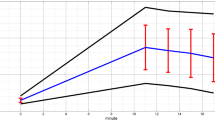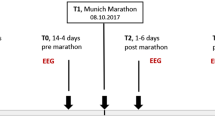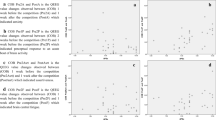Abstract
The objective of this study is to identify markers of the addictive condition developing in athletes during exercise deprivation by analyzing electroencephalograms (EEGs), electromyograms (EMGs), skin temperature measurements, sympathetic nervous system activity, levels of anxiety and depression (by psychological tests). A cohort of professional football players (N = 50) voluntarily participated in the study. The athletes were tested under two test conditions: during active training sessions and during exercise deprivation (for seven days). The analyzed results have shown that the functional state of athletes with exercise addiction (due to exercise deprivation), compared with athletes showing no addictive behavior, was characterized by lower brain bioelectric activity (a decrease in the α-rhythm amplitude and power), growth in the muscular tension, increased sympathetic activity, and elevated levels of anxiety and depression. We have concluded that an athlete’s functional state during exercise deprivation is an important predictor for exercise dependence. A prolonged exercise deprivation causes intense psychophysiological changes in the body of athletes inclined to exercise addiction. The obtained results may be useful for experts in the field of sports medicine, as well as for further studies in different types of addictions.
Similar content being viewed by others
References
Peniston, E.G. and Kulkovsky, P.J., Neurofeedback in the treatment of addictive disorders, in Introduction to Quantitative EEG and Neurofeedback, Abarbarnel, A. and Evans, J.R., Eds., London: Academic, 1999, p. 157. doi 10.1016/B978-012243790-8/50008-0
Egorov, A.Yu., Nekhimicheskie zavisimosti (Nonchemical Dependences), St. Petersburg: Rech’, 2007.
Landolfi, E., Exercise Addiction, Sports Med., 2013, vol. 43, no. 2, p.111.
Carron, A.V., Hausenblas, H.A., and Estabrooks, P.A., The Psychology of Physical Activity, New York: McGraw-Hill, 2003.
West, R. and Gossop, M., Overview: A comparison of withdrawal symptoms from different drug classes, Addiction, 1994, vol. 89, no. 11, p. 1483.
Carter, A. and Hall, W.D., Addiction Neuroethics: The Promises and Perils of Neuroscience Research on Addiction, Cambridge: Cambridge Univ. Press, 2012.
Aidman, E.V. and Woollard, S., The influence of selfreported exercise addiction on acute emotional and physiological responses to brief exercise deprivation, Psychol. Sport Exercise, 2003, vol. 4, no. 3, p.225.
Draeger, J., Yates, A., and Crowell, D., The obligatory exerciser. Assessing an overcommitment to exercise, Pysician Sports Med., 2005, vol. 33, no. 6, p.504.
Hausenblas, H.A. and Downs, D.S., Exercise dependence: A systematic review, Psychol. Sport Exercise, 2002, vol. 3, no. 2, p.89.
Shtark, M.B., Technology for correction of psychophysiological aspects of addictions by the method of EEG alpha-stimulation training on heart rate, in Bioupravlenie v meditsine i sporte (Bioregulation in Medicine and Sports) (Proc. II All-Russian Conference), Omsk, 2000, p.21.
Iznak, A.F. and Nikishova, M.B., Electrophysiological correlates of psychogenic disorders, Hum. Physiol., 2007, vol. 33, no. 2, p.250.
Bazanova, O.M., Electroencephalogram alpha activity: Modern interpretations, Usp. Fiziol. Nauk, 2009, vol. 40, no. 3, p.32.
Davidson, R.J., Anterior electrophysiological asymmetries, emotion, and depression: Conceptual and methodological conundrums, Psychophysiology, 1998, vol. 35, no. 5, p.607.
Grin’, V.V. and Kozmidiadi, A.O., Possibilities of EEG use for early diagnosis and detection of addictive state predictors, Med. Panorama, 2007, no. 8, p.55.
Zigmond, A.S. and Snaith, R.P., The hospital anxiety and depression scale, Acta Psychiatr. Scand., 1983, vol. 67, no. 6, p.361.
Griffiths, M.D., Szabo, A., and Terr, A., The exercise addiction inventory: A quick and easy screening tool for health practitioners, Br. J. Sports Med., 2005, vol. 39, no. 6, p.30.
Einthoven, W., The string galvanometer and the measurement of the action currents of the heart, in From Nobel Lectures, Physiology or Medicine 1922–1941, Amsterdam: Elsevier, 1965, p. 1922.
Gapin, J.I., Etnier, J.L., and Tucker, D., The relationship between frontal brain asymmetry and exercise addiction, J. Imagery Res. Sport Phys. Act., 2009, vol. 5, no. 1, p.135.
Baevskii, P.M. and Ivanov, G.G., Heart rate variability: theoretical aspects and possibilities of clinical use, Ul’trazvuk. Funkts. Diagn., 2001, no. 3, p.106.
Merletty, R., Standarts for reporting EMG data, J. Electromiogr. Kinesiol., 1999, vol. 9, no. 1, p.3.
Berczik, K., Szabó, A., Griffiths, M.D., et al., Exercise addiction: Symptoms, diagnosis, epidemiology, and etiology, Subst. Use Misuse, 2012, vol. 47, no. 4, p.403.
Jee, Y.S., Exercise addiction and rehabilitation, J. Exerc Rehabil., 2016, vol. 12, no. 2, p.67.
Antunes, H.K., Leite, G., Lee, K.S., et al., Exercise deprivation increases negative mood in exerciseaddicted subjects and modifies their biochemical markers, Physiol. Behav., 2016, vol. 156, p.182.
Weinstein, A. and Weinstein, Y., Exercise addiction–diagnosis, bio-psychological mechanisms and treatment issues, Curr. Pharm. Des., 2014, vol. 20, no. 25, p. 4062.
Soroko, S.I. and Trubachev, V.V., Neirofizilogicheskie i psikhofiziologicheskie osnovy adaptivnogo bioupravleniya (Neurophysiological and Psychophysiological Basics of Adaptive Biocontrol), St. Petersburg: Politekhnika–Servis, 2010.
Golovin, M.S., Balioz, N.V., Aizman, R.I., and Krivoshchekov, S.G., Effect of audiovisual stimulation on the psychophysiological functions in track-and-field athletes, Hum. Physiol., 2015, vol. 41, no. 5, p. 532.
Author information
Authors and Affiliations
Corresponding author
Additional information
Original Russian Text © S.G. Krivoschekov, O.N. Lushnikov, 2017, published in Fiziologiya Cheloveka, 2017, Vol. 43, No. 6, pp. 80–87.
Rights and permissions
About this article
Cite this article
Krivoschekov, S.G., Lushnikov, O.N. The Functional State of Athletes Addicted to Exercises during Exercise Deprivation. Hum Physiol 43, 678–685 (2017). https://doi.org/10.1134/S0362119717040077
Received:
Published:
Issue Date:
DOI: https://doi.org/10.1134/S0362119717040077




